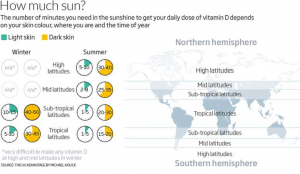Sunlight: Did You Know It Helps Reduce our Blood Pressure?
Posted by Phil Heler on January 31, 2020How much sunlight we absorb really does matter as it promotes our Vitamin D status and reduces our blood pressure.
Sunlight or lack of it makes a difference not just to our mood but also to Vitamin D status and to our blood pressure (which few of us realise). If I had my own personal Room 101 winter would be somewhere at the top. John Steinbeck the American author who won the Nobel Prize for Literature in 1962 wrote ‘what good is the warmth of summer, without the cold of winter to give it sweetness’ but I have mixed feelings about this. One my favourite quotes, indirectly associated with winter weather, was an unknown person who referred to the Winter Olympics as an event that comprised of ‘letting white people win at sports no one else can afford to learn’. But clearly it would be a little unfair to pick on an event that has a four-year cycle that is next being held in Beijing in 2022.
Why we receive less sunlight in the Northern Hemisphere
The coldest temperature ever recorded in the UK in winter was -27.2 °C, which has been recorded 3 times in 1895, 1982 and 1995 in the Scottish Highlands. Generally, the winter of 1963 is one of the coldest on record and certainly the coldest since 1740. Temperatures consistently reached lower than – 20 °C with blizzards, snowdrifts and even the sea freezing around the coast. On 29th and 30th December, a blizzard struck the UK with snowdrifts up to 6 metres deep. Snow continued to fall frequently and until early March 1963, much of the UK remained covered in snow.
I am not easy pleased it would appear. If we have a mild winter that is indistinct from autumn and spring this gives us eight months of grey skies interspersed with rain and I tire from the monotony or conversely if it snows, I then despise the inconvenience. Winter is incongruous. There are even two different dates when winter could be possibly said to begin depending on whether we are referencing the Meteorological or Astronomical winter. Winter is specifically defined by the Earth’s orbit around the sun when the south pole is tilted towards the sun, so this officially commences on the winter solstice of December 21st or 22nd; hence the shortest day of the year. However, a fixed date of December 1st is used to start Meteorological winter so we can record and measure climate data at a fixed point.
Many people also believe that the temperature changes because the Earth is closer to the sun in summer and farther from the sun in winter; in fact, it is the opposite! We are ironically closest to the sun during winter. At the beginning of January when the Earth reaches ‘perihelion’ (‘peri’ meaning near and ‘helion’ meaning sun) we are 3.1 million miles closer to the sun than we are in early July (which is termed ‘aphelion’). It is warmer in the summer only because we in the northern hemisphere face the sun.The reason there is a difference in how much sunlight we receive is in part because Earth is quite literally tilted on its vertical axis at an angle of 23.44 degrees. This dictates the angle at which sunlight reaches the Earth’s surface. Clearly in summer the sunlight hits the northern hemisphere at a steep angle and, conversely, a shallow angle in winter when the arc of the sun is much lower. As human beings we are designed, up to a given point, to interact with ultraviolet light in sunshine, so how much we receive does matter.
Sunlight light and Vitamin D
How much sunlight we receive and absorb really does matter. We all know about vitamin D. The chart below gives some indication of what is required in terms of minutes of sunshine exposure in different parts of the world to top up our daily dose of vitamin D depending on how dark our skin tone is. The daily required exposure is very much lower than the dose required to give you sunburn. Unlike other vitamins, vitamin D functions like a hormone, and every single cell in your body has a receptor for it. Your body makes it from cholesterol when your skin is exposed to sunlight which most of are aware of. The recommended daily intake (RDI) is usually around 400–800 IU, but many experts say more is better.
All vitamins are of course present in minute amounts in natural foodstuffs. However, vitamin D is only found in certain foods such as fatty fish and fortified dairy products, although it’s very difficult to get enough from diet alone so we require another source (sunlight). About 10% of people in the UK have inadequate amount of vitamin D levels in the summer, rising to nearly 40 per cent during the winter months. For this reason, in 2016, the UK’s Scientific Advisory Committee on Nutrition recommended that everyone should consider taking vitamin D supplements during winter, because there is good evidence that they can make a difference to bone and muscle health. But there is more to sunlight that just vitamin D.
Generally speaking, sunlight does promote good health, but it is becoming increasingly apparent that this is just because of vitamin D alone. It has been demonstrated that people with a high vitamin D status do tend to be healthier and are less likely to have high blood pressure, diabetes, strokes or heart attacks – in fact, they are less likely to die prematurely of any cause. So, the direct assumption was of course that vitamin D supplementation would replicate this pattern. Unfortunately, as scientific investigation is proving, this is not necessarily the case, perhaps there is another reason that runs parallel with vitamin D status. While bone and muscle health clearly improve from vitamin D supplements, it would appear they have little effect on blood pressure and the cardiovascular system. So, what is missing?
Ultraviolet light Helps Promote Nitric Oxide which Helps Reduce Blood Pressure
In 1998 the Noble Peace Prize in Physiology and Medicine 1998 was awarded jointly to Robert Ignarro and Ferid Murad. They discovered that nitric oxide is an important signalling molecule in the cardiovascular system. As it happens one of the important mediators in the production of nitric oxide is sunlight which helps release this gas from the skin! This apparent simplicity belies how important nitric oxide is. Nitric oxide has many roles, but a major one is the Nobel prizewinning discovery that it dilates blood vessels and controls blood pressure.
The skin contains large quantities of nitrate, which the ultraviolet (UV) radiation in sunshine converts into nitric oxide. When nitric oxide enters the circulatory system, it lowers blood pressure slightly and this is influential. High blood pressure is of course the world’s leading cause of premature death and disease, because it leads to stroke and heart disease. Even a small reduction of blood pressure across the whole population will reduce overall rates of stroke and heart attack, and sunlight may well do this, simply by getting the skin to release nitric oxide into the blood. This also probably gives the answer to a long held question. Why is the average blood pressure of the UK population lower in summer than winter? There is also a correlation between latitude and blood pressure, with people living closer to the equator having lower blood pressure than those at higher latitudes.
Benefits of sunlight are Supported by Research
Obviously skin cancer is a threat from exposure to the sun but epidemiological studies performed in the 1990’s are demonstrating some interesting results. A survey of 30,000 Swedish women recruited in 1990 and questioned about their sun-seeking behaviour found an interesting correlation. It appeared the more they had sunbathed, the less likely they were to have died 20 years later. In fact, those who did the most sunbathing were half as likely to be dead as those who had avoided the sun entirely. Vitamin D is often used as a euphemism for “healthy sunlight”, but an increasing number of supplementation studies show that the benefits of sunlight cannot all be put down to it. Nitric oxide may be at least as important. Sun has benefits as well as risks, and our public health advice needs to reflect this.


